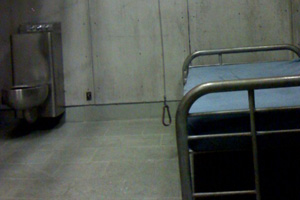Over the past few years there has been a growing interest in the increasing numbers of older prisoners. At times this interest has been accompanied by some piddling gestures to alleviate their miserable situation–for example, theoretically granting them leave to die “in the free world,” or perhaps showing sympathy for granny having to climb up three tiers of bunks to get a night’s sleep, or gramps asking for a cane (denied because it is a possible weapon) so he can get to the toilet without crawling.
Nonetheless, the dominant view from the corrections industry and most of the public is that these people did the crimes and now they have to do the time–even if the time reflects absurdly the long sentences instituted in the 1980s and 90s, and creates a new cohort of septuagenarian prisoners. In fact, most of the new interest in aging inmates actually has to do with money. According to a recent AP article:
The ACLU estimates that it costs about $72,000 to house an elderly inmate for a year, compared to $24,000 for a younger prisoner.The federal Bureau of Justice Statistics reported that the number of men and women in state and federal prisons age 55 and older grew 76 percent between 1999 and 2008, the latest year available, from 43,300 to 76,400. The growth of the entire prison population grew only 18 percent in that period.
“We’re reaping the fruits of bad public policy like Three Strikes laws and other mandatory minimum sentencing laws,” said David C. Fathi, director of the ACLU National Prison Project in Washington, D.C. “One in 11 prisoners is serving a life sentence.”
With prison costs escalating and states overwhelmed with deficits, letting granny and gramps out of the clink suddenly doesn’t sound so bad to some state officials. Old prisoners are expensive, and if we must take care of them, then why should local and state government’s foot the bill. Better to let the federal government pay instead, through Medicare and Medicaid. The leading predictor of criminal behavior is age (young), so there’s little risk involved in letting the geezers go; all that’s keeping most of them behind bars in the nation’s insatiable taste for punishment.
With all this in mind, I am reprinting an article that just appeared on Solitary Watch, another blog where I am editor along with Jean Casella. It is the story of Robert Platshorn, leader of the “Black Tuna Gang” of marijuana smugglers in the late 1970s, an experience described in his book The Black Tuna Diaries. In 1980, he received what was then an unprecedented sentence of 64 years in federal prison.
When Platshorn was released on parole in 2008 at the age of 65, he was the longest-serving non-violent marijuana offender in America. But as he wrote in a blog post for High Times earlier this year, that distinction “won’t be mine for long. Many sentenced after me will soon be able to claim my title. They are serving LIFE WITHOUT PAROLE and will never get to spend another minute as a free man.” When Platshorn was convicted, he writes, “no one received a life sentence for marijuana. That changed in the early 80′s as Reagan stepped up this insane failure of a drug war.” According to Platshorn, several other non-violent marijuana offenders, including Billy Deckle, are now in their sixties and seventies, and will likely never be released.
Here is what they have to look forward to: Surviving day to day in an environment so dangerous that a slip of the tongue often ends in death. Since the elimination of parole, federal prisons are populated mainly by young, uneducated, aggressive inmates serving absurdly long sentences. They have little hope and nothing to lose. Violence has become endemic in a system that has little or no reward for good behavior. Prison gangs find older non-violent inmates easy prey.
Inadequate medical care. It costs the taxpayers billions to provide even minimal health care for older inmates. Yet these are the people least likely to commit a crime after release. An older marijuana offender serving a long sentence is likely to die in prison for lack of medical care…
An extremely unhealthy diet. It becomes an obsession, trying find enough decent food to maintain good health. Even under the best of circumstances, it’s no longer possible. When I entered prison in 1979, the budget to feed an inmate for three meals a day was $2.62. When I left prison in 2008 it had shrunk to $2.25…This has to pay, not only for food, it has to cover repairs and replacements for kitchen equipment, civilian salaries, and eating utensils…You don’t have to be an economist to figure out, that since Bush decimated the prison food budget, the cost of inmate medical care has skyrocketed. Especially for older inmates, many of whom require a special or restricted diet…Now, the Bureau [of Prisons] will say that they provide special diets for those who require them. And it’s true. Sort of! Those diet trays usually contain so little edible food that the starving sick geezer ends up eating a piece of deep fried breaded sewer trout or a hunk of fried breaded mystery meat, just to stave off the terrible never ending hunger pangs. The results, a sick geezer who now needs expensive medications and has little or no chance of surviving a long sentence. Most of those geezers would pose no threat to society if released. It’s even worse when the geezer is serving forever for marijuana, a harmless substance, and an effective medication that is now legal in many states. How would you feel if that old pot smuggler was your Uncle Billy?
Geezer in the hole! “The Hole”! Segregation!…The Federal Bureau of Prisons thinks it sounds better if they call it the SHU (Special Housing Unit). Take my word for it, it ain’t special in any way you’d like to experience. During my almost 30 years in 11 different federal prisons, about 3 1/2 years were spent in segregation. They got it right in the old movies, “the hole”. Now you might ask, why would a nice non-violent old dude wind up in the hole? Lots of reason! Someone “drops a note” saying the old dude’s life is in danger. Result many months in the hole. He gets in a fight. Doesn’t matter if it’s self-defense. Into the hole! Uncle Billy gets caught coming out of the chow hall with an apple or a cookie in his pocket. The hole! The old pot smuggler has been forced to work in the prison factory because he owes a fine. A tool disappears from his work area. Everyone who works in that area is tossed in the hole. And so on and so on. Now what happens is: he has to eat whatever shows up on the meager tray that comes through the slot, or starve. Mostly he eats all the starchy crap because he’s been flat on his back all day and night, and he’s bored to death. Meals are the only break he looks forward to. Each time he leaves his cell his hands are cuffed behind his back. This is especially painful for an older inmate. He has to be cuffed while he crouches backwards with his hands pushed out through the lower food slot. This usually means Uncle Billy will forgo his three weekly showers and exercise periods. It’s no big deal when your young and supple, but for a geezer it’s a different story. The only way I can express it is, if you are over fifty, spend 90 days in the hole and you come out two years older. Fatter, slower, more depressed, and less likely to recover physically or mentally.
Its time for all the Uncle Billys to go home…












